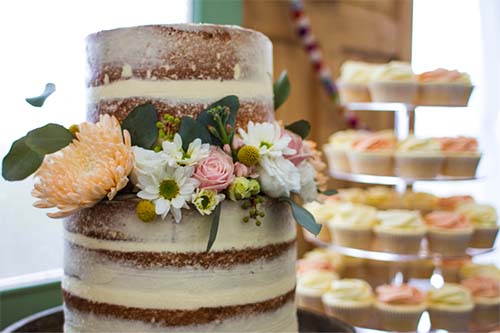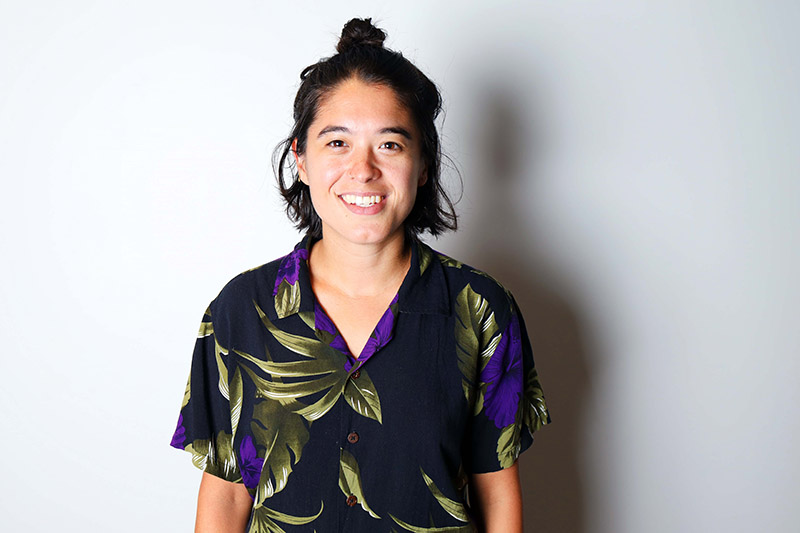I’m getting married this summer, and maybe I’m crazy, but I’d like to bake my own wedding cake. The pastry module in the Culinary Arts program was one of my favorites when I was a student, and the process of testing out different flavors and fillings promises to be a delicious endeavor.
Looking through recipes like Chef Penny Stankiewicz’s Ultimate Birthday Cake or her Peanut Butter & Jelly Cake, I uncovered a flaw in my plan. I don’t want to bake that much cake. It would be a lot of work to make multi-layered cakes just to get a taste, and the ingredient costs — and the inches to my waistline — would indeed add up.
A six-inch round pan is the smallest I have, but many recipes call for an eight-inch or 10-inch round pan, a 9x13-inch rectangular pan and even half-sheet pans. For help, I turned to Pastry & Baking Arts Chef-Instructor Ravindra Verma to teach me how to modify a recipe when using a different pan than the recipe calls for. He also shared some pointers to make the conversion process easier and ensure better baking.

Formula for Calculating Baking Pan Volume
This post is about cake math after all, and here's where pi — the other pie — comes in. To adjust a recipe for your desired yield, Chef Ravi explains the first step is to calculate the volumes of the two pans — the size the recipe calls for and the one you want to use. Then, divide them to get the factor, which is what will be multiplied with each ingredient to determine the adjusted quantities you’ll need to use.
Chef Ravi’s formulas, along with examples of how to use them, are as follows:
Volume of a round pan = π [x r(radius of pan)] ^2 x h (height of pan)
Volume of a square or rectangular pan= length x width x height of pan
Factor= (volume you want)/(volume of recipe)
Example 1: Converting More Cake to Less Cake
For example, Chef Penny’s Ultimate Birthday Cake uses four eight-inch round pans that are three inches tall, but I want to make one six-inch round cake that’s two inches in height. First, I calculate the total volume for what Chef Penny’s recipe calls for and the pan size for what I want to make:
Volume of Chef Penny's recipe= π x 4^2 x 3 x 4 (four pans) = 602.88 cubic inches
Volume of 6" pan = π x 3^2 x 2 = 56.52 cubic inches
I divide those two numbers to calculate the factor:
Factor= [56.52 (volume of cake I want)] / [602.88 (volume of Chef Penny's recipe)] = 0.09
And then multiply the recipe’s ingredients by the factor. Chef Penny’s recipe calls for 540 grams of white sugar, so to calculate the adjusted quantity I need:
540g x 0.09 = 48.6g white sugar
Example 2: Converting Round Cakes into a Sheet Cake
Say a vanilla cake recipe yields two 12-inch round cakes (pans are two inches tall), but you want one half-sheet cake. First, calculate the volume of the pans:
Volume of half sheet pan = 13 x 18 x 1 = 234 cubic inches
Recipe yields = π x 6^2 x 2 x 2 = 452.16 cubic inches
Divide the two numbers to calculate the factor:
Factor= [234 (the volume of cake I want)] / [452.16 (volume of recipe)] = 0.51
Multiply each ingredient in the recipe by 0.51 to get enough batter for a half-sheet cake:
200g x 0.51 = 102g white sugar
Use these same calculations to scale recipes up and down or to convert between circle and rectangular pan shapes.
Measure by Weight and Go Metric
For greater accuracy, Chef Ravi highly recommends measuring ingredients by weight instead of volume. If you don’t have a kitchen scale, here’s more on why it’s necessary according to ICE Pastry & Baking chefs.
And, while you’re ditching the measuring cups and spoons, Chef Ravi underscored the benefits of using the metric system instead of the imperial system. He gives an example: imagine trying to divide a third of a cup of oil by four or five, versus dividing 1,000 grams by the same number. If your recipe uses imperial measurements, consider converting it to metric. Weighing ingredients and using the metric system leave less room for error and will make conversions easier.
Adjusting Bake Time
When the ingredient quantities have been adjusted, the batter’s made and in the pans, all that’s left to do is bake. While bake time depends on a number of factors including the kind of cake and oven type, Chef Ravi noted that taller cakes take longer to bake than shallow cakes.
So, if the recipe made a half-sheet cake but you’ve switched it up to yield a 6x3-inch cake, you’ll need to increase the bake time and may need to reduce the oven’s temperature. He also mentioned that cake batter with a higher liquid content, like carrot cake or red velvet cake, takes longer to bake than cakes with less liquid, such as a pound cake.
One last slice of wisdom from Chef Ravi: Keep in mind that baking is a science where accuracy plays a big role in a recipe’s outcome. So do your math, then eat your cake!
Related: How to Start a Home Bakery






